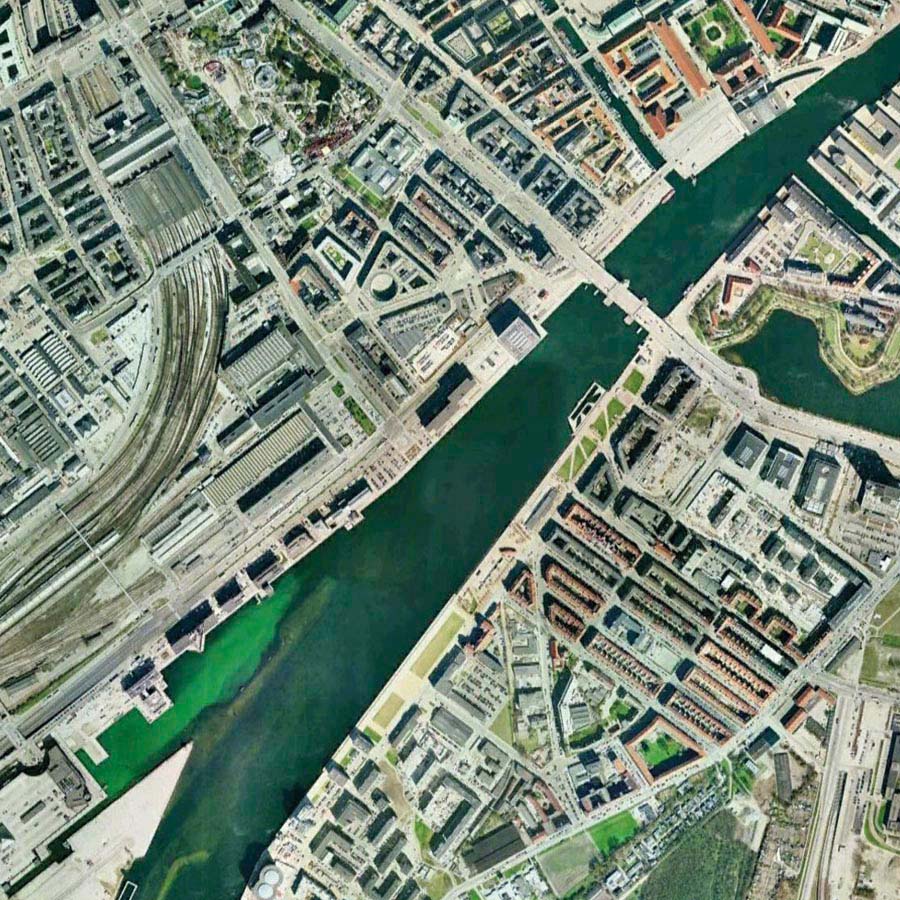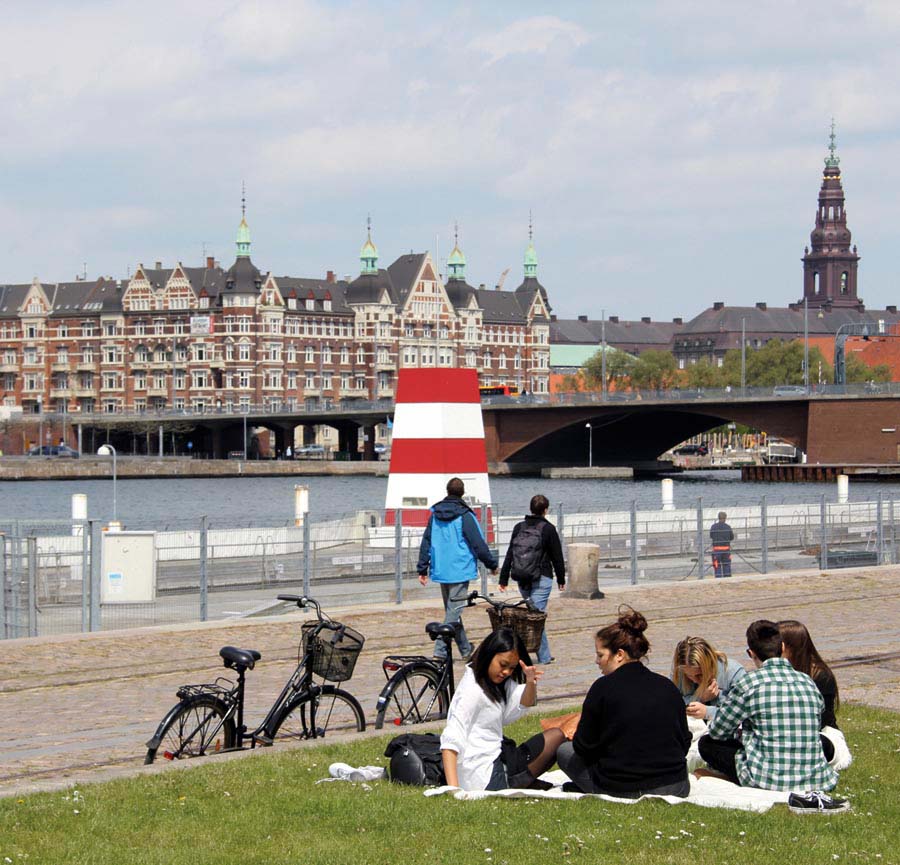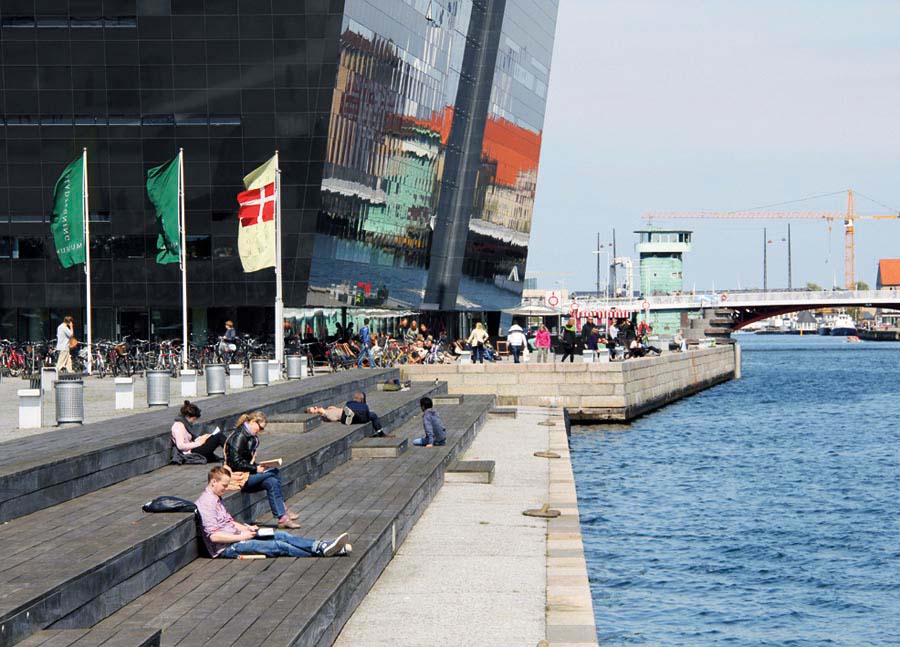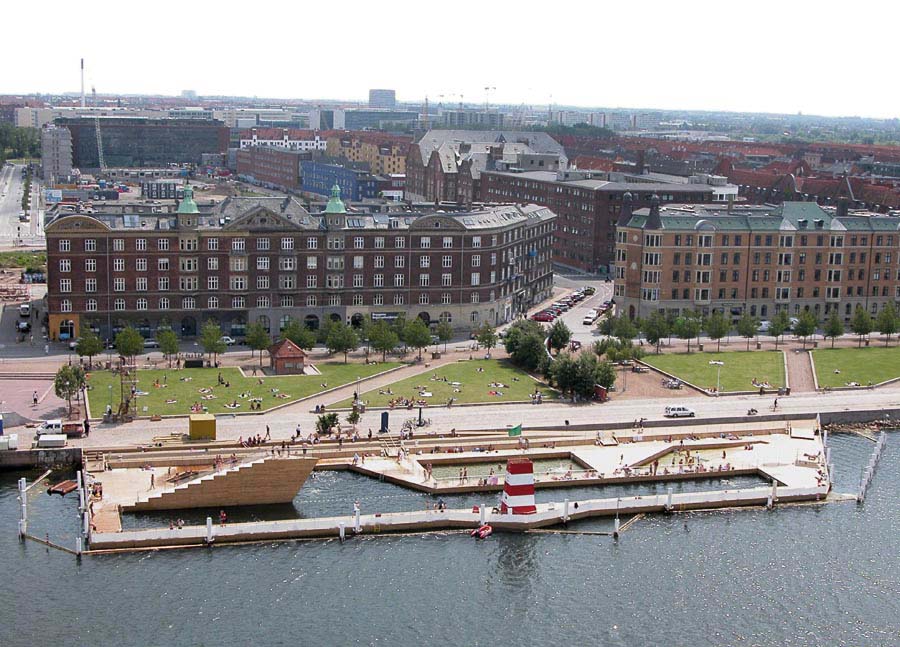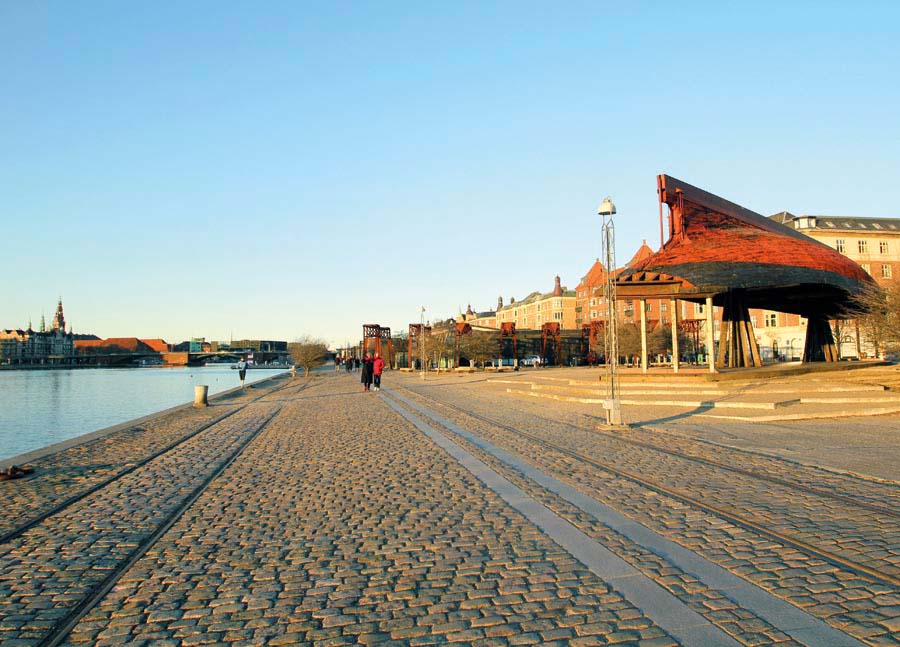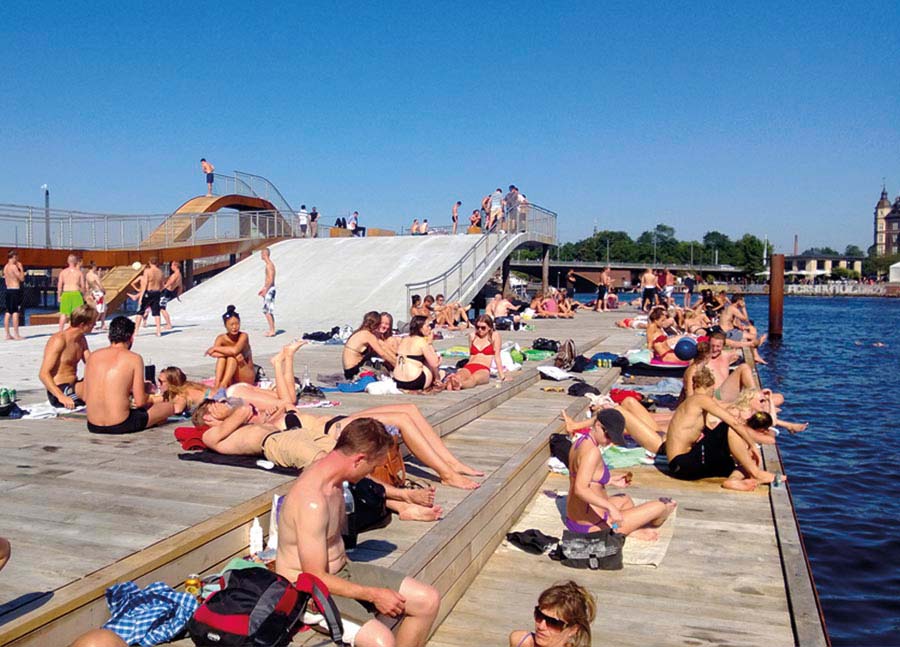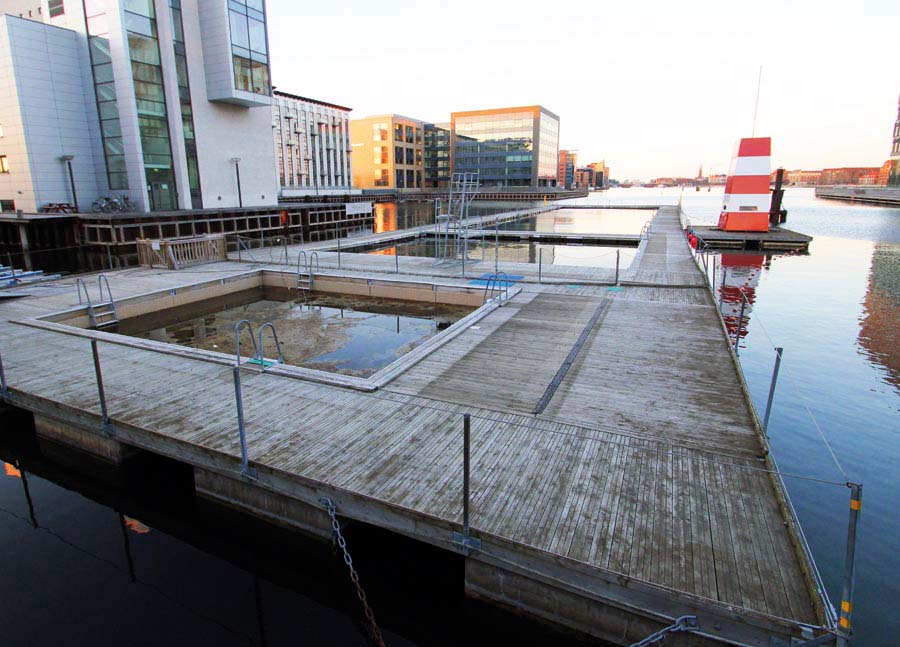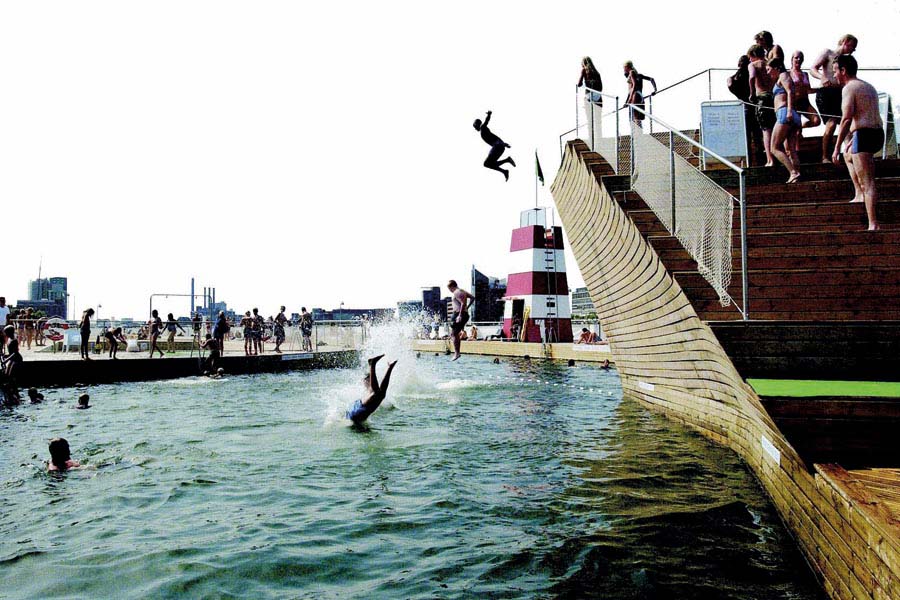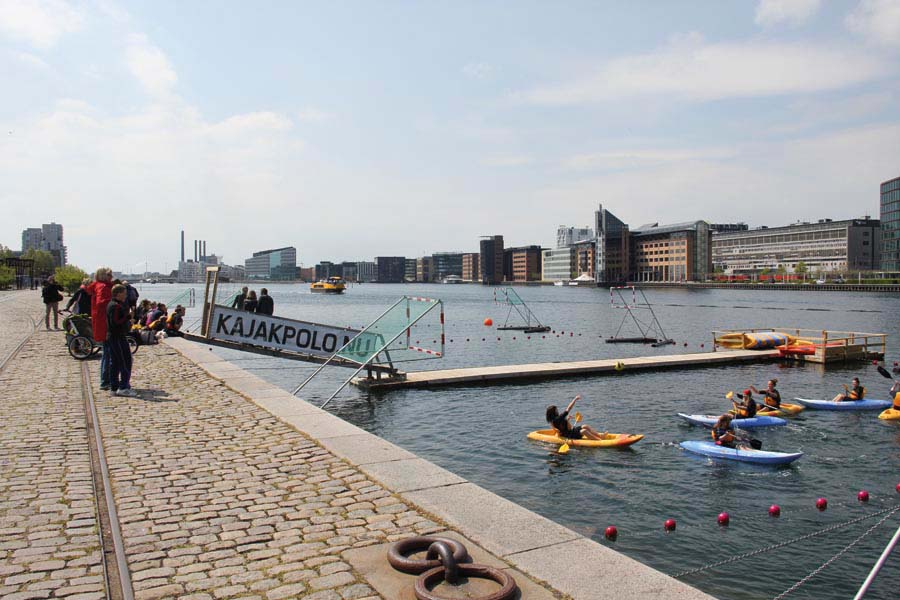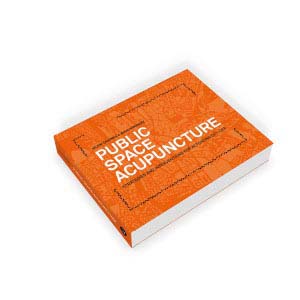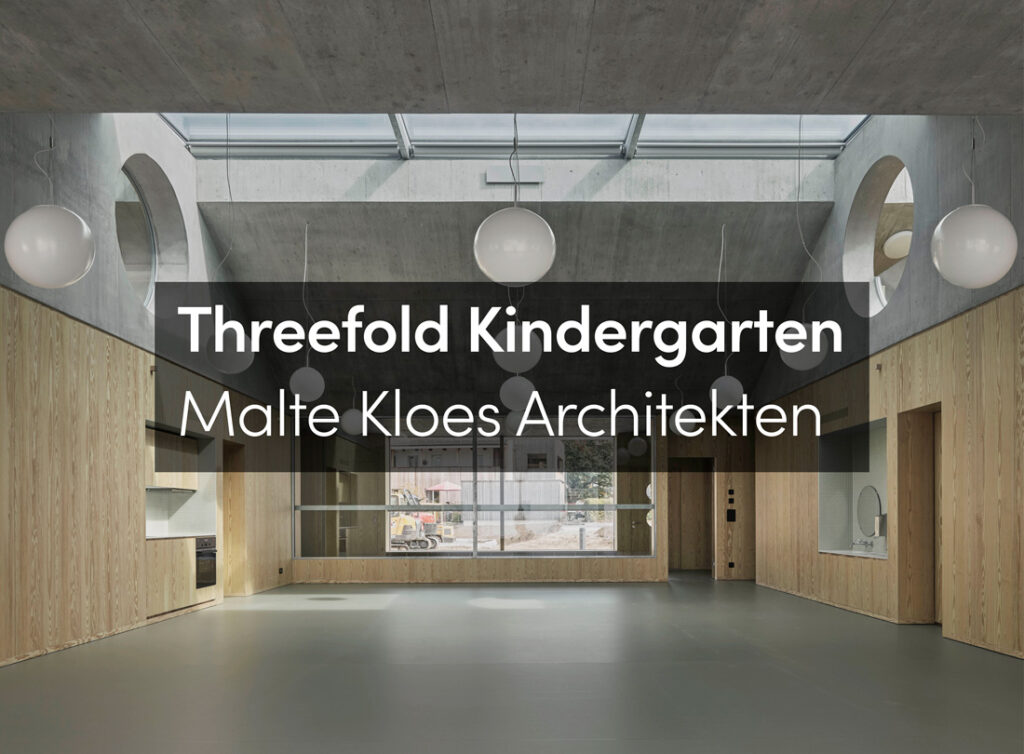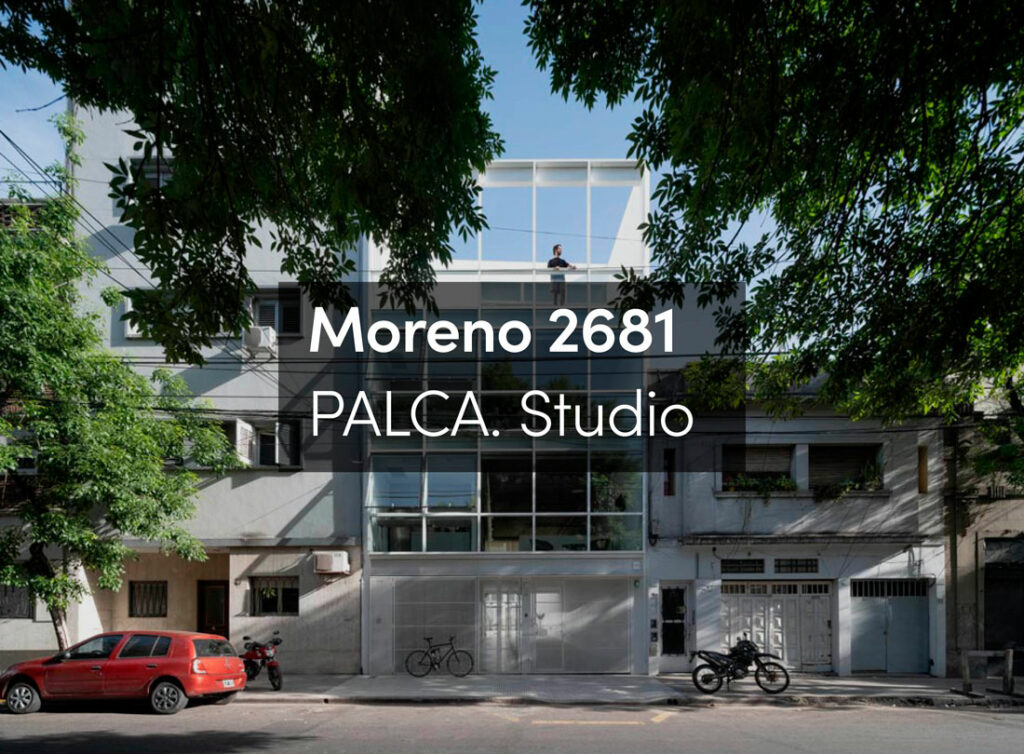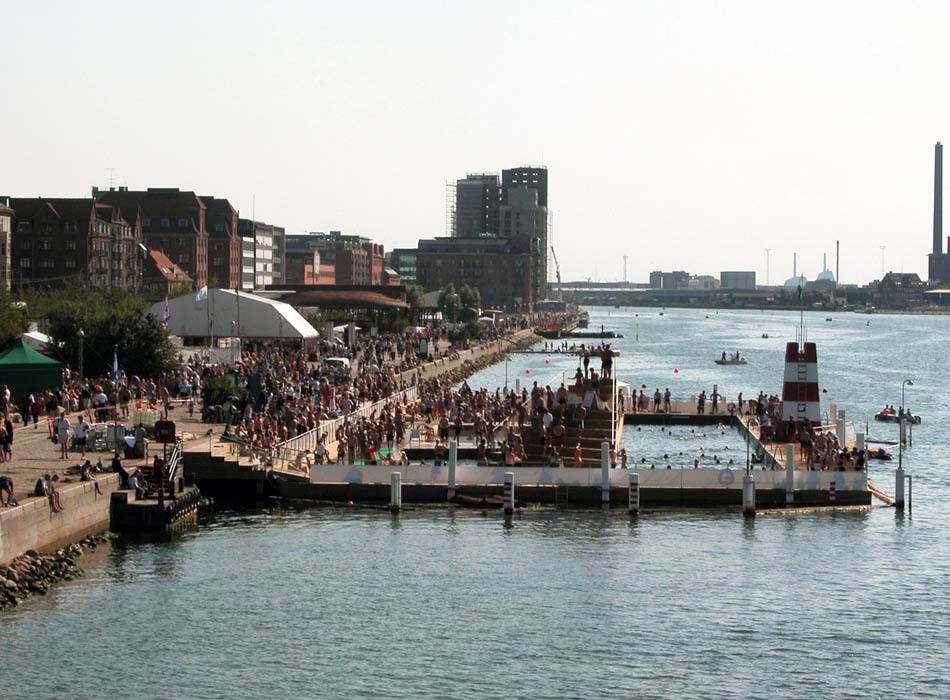
The development of Copenhagen’s harborfront can be considered an integral strategy for regenerating public life along the water, which has been subdivided into several parts, due to its scale and complexity. The elements that provide functional and spatial unity to the strategy are the public transportation network (water taxi and water bus) that transforms the water into a virtual street, the landscape projects developed along the waterfront, and the water promenade along the quay, which, together with the construction of new bridges, allows for continuous pedestrian and bicycle circulation along both sides of the harbor. Several independent interventions located at strategic points along the harborfront have been implemented to add specific activities to the place and to work as visual landmarks that link the citizens’ experience of the public space with the history of the site.
The different interventions articulate pedestrian movement along the harborfront by creating visual and functional tension along the waterside. Among them, some of the harbor baths work as a series of floating interventions that can be cloned and easily transported along the water to different points. The harbor bath located in the north, near Langebro bridge, serves to attract citizens and is conceptually linked to the harbor pool in the south, close to the pedestrian and bicycle bridge that leads to Fisketorvet. The People’s Park and its harbor beach work as visual and physical connectors that link the two bridges. The beach steps, located in the southern part of the park create an area for resting close to the water, which relates to the terraces of the public square to the north, located in between the café terrace of the National Library and the water bus stop nearby. The strategy for regenerating public space along the harborfront consists of separate, nearly independent interventions, some of which were realized in different periods, yet they all relate to each other to create a balanced and coherent whole.
Aside from regenerating the public space from a spatial and functional point of view, the strategy seeks to integrate the harbor into the urban life of the city and to provide a sense of place. Although some interventions establish a certain dialogue with the history of the place, the strategy does not try to provide a sense of place by looking back into its past as a harbor, but by creating a new type of public space for the city, characterized by its own identity. By cleaning the water in the former harbor area and building floating interventions, an unused space of the city is transformed into a performance space. The many seating areas, café terraces and gathering spaces around the water characterize the public space as an urban stage where citizens play the role of actors and spectators in the performance of public life.
It stands to mention that building a new architectural backdrop, like Haussmann did in Paris in the 19th century, was not necessary to transform in this case public space into an urban stage. On the contrary, it was enough simply to promote new aquatic activities, such as swimming, canoeing and different water sports, supported by a series of scenographic elements, like the floating pools, to shift the focus of attention onto the water front. In this sense, the typology of the created urban stage does not adhere to the principles of the classical theatrical tradition, initiated by Greco-Roman theater, where the action is framed by an architectural background or a backdrop that reproduces the illusion of being in a different place. Instead, it resembles certain plays or contemporary dance pieces that lay bare the undressed back wall of the theatre or the real nature of the place where the performance happens.
The architectural background does not play the role of a figurative urban stage, recreated with industrial buildings, old ships and out-of-service cranes that could cause visitors to perceive the urban space as part of a port that no longer exists, but rather it is an abstract stage formed by modern buildings, facilities and green areas that enable the port to be perceived as a river.
The water functions as a theatrical stage, and the spectators line up in front of it on both shores. As opposed to the layout of classical theater where the audience faces the stage so that their attention is concentrated on the performance, this arrangement, adopted in more contemporary theater, places the stage in the middle of the audience, involving the spectators, to a certain extent, as part of the performance. This fact reinforces the citizen’s role as actor and spectator at the same time, one who watches and is watched. It also lends depth and dynamism to the urban stage, augmenting its attractiveness and inviting people to cross over to the other shore to experience what others are experiencing, to see what they are seeing.
In conclusion, the strategy identifies public space as a representational space, transforming the city into a theater with the objective, in this case, not only of activating public life in a disused part of the city, but also of providing meaning for the place itself.
Urban Analysis
The Copenhagen harbor was active until the 1980s when many industries closed down. Since then, a large transformation of the sites along the harbor has been combined with major investments in sewage treatment to improve the water quality. The new neighborhoods mix residential and office facilities with new public spaces along the harbor, acting as a new leisure center for the city. Its excellent location at the edge of the historical city and the mix of activities that combines housing and offices with restaurants and cafés make this fragment of the Copenhagen harborfront a very popular new area of the city. New transportation systems along the harbor such as four water bus lines and a large variety of recreational facilities such as green areas for sunbathing, two restaurants, children’s playgrounds, the Harbor Baths, water polo areas and sports facilities have resulted in extensive use of the harborfront, both by local residents and by other citizens of Copenhagen alike.
Social Analysis
The city of Copenhagen has a large population of singles living alone, who occupy half of the city’s apartments, while only a third of them are occupied by couples. That means that more than three quarters of the residential units are inhabited by just one or two people, while only 22% of the houses are occupied by families. Immigrants represent 17% of Copenhagen’s population, and the unemployment rate was 8% in 2011.
Interventions
The interventions realized to regenerate urban life in the public space along Copenhagen’s harborfront are many, built in different periods and spread across many kilometers of waterfront.
This study has been reduced to five main interventions located along a small 1.5-kilomter stretch of the harbor, which is limited by the National Library building at the north end and the Bryggebroen Bridge to the south. Some of the interventions were specifically designed for their locations, while others, such as the Harbor Baths, are generic interventions that are repeated at several points along the waterfront.
Black Diamond Square
The National Library, popularly known as the Black Diamond, is a city landmark that visually marks this zone of the harbor. The café-terrace outside the Library has become a popular public place on the waterfront. Its wooden platform is connected with a square to the south where a few long benches are placed adjacent to the café entrance and there are several long wooden steps for sitting on that face the harborfront, acting as a small theater for observing the life of the harbor. The strategic location close to the library and easy connection with other parts of the city, via a nearby water bus stop, make this place a popular space to meet, read, and sunbathe in summer.
Harbor Bath at Islands Brygge
Designed by the architects Julien de Smedt and Bjarke Ingels and built in 2003, the Harbor Bath has a total of 5 pools and a capacity for 600 people. There are two 50-meter-long swimming pools, two children’s pools and a diving pool with three- and five-meter springboards.
The Harbor Bath was not only designed as a place for exercise, but as a place to socialize, play and enjoy the sun. It was built following the improvements of the water quality in the harbor and it soon became a symbol of the harbor’s regeneration.
Havneparken in Islands Brygge
The urban renewal in Islands Brygge contains a long waterfront park named Havneparken. The main landscape intervention, located at the center of the park, integrates a fragment of a railroad track and an old train car to remind visitors of the site’s industrial past. A bandstand, built by reusing a former ship’s hull, refers to the former function of the place as dockyards. Some old steel structures that have been left behind now serve as pergolas, and fragments of demolished industrial buildings have also been kept. The intervention, aside from transforming a former industrial harbor into a meeting area for citizens, plays a role in commemorating the history of the site.
Kalvebod Waves
The new Harbor Bath located at Kalvebod Brygge was designed by JDS architects and occupies an area of 8,500 m2. A sinuous wooden promenade connects the edge of the pier with the water enclosing two plazas, several facilities and swimming pools. The waving promenade also connects the harbor level with higher belvedere platforms fitted with seats for enjoying panoramic views. Walking promenades, resting zones and sport areas are intertwined into a three-dimensional sculptural intervention characterized by a hilly silhouette.
Harbor Bath at Fisketorvet
In 2002, this Harbor Bath was located at Islands Brygge. When a new Harbor Bath, designed by PLOT, was built for that location in 2003, the old one was moved to its current site.
It is located in a frequented area in front of Fisketorvet shopping center and close to the Bryggebroen bicycle and pedestrian bridge, which is used daily by 9,000 cyclists to cross the harbor. The Harbor Bath contains three separated pools: a 0.70-meter-deep children’s pool, a diving pool equipped with three diving boards, and a swimming pool. Access to the pools is free and lifeguards oversee the facilities.
Process
Copenhagen’s harborfront has been developed through a long process divided into several phases, focused on different areas. In the 1970s there were no parks in the area of Islands Brygge. The commercial and industrial harbor had always stood as a barrier between the existing residential area and the water. In 1978 local residents organized an action committee directed by the architect Poul Jensen and his wife, the landscape architect Annelise Bramsnæs, to prevent a new vacant area from being built, proposing its transformation into a park. In 1983, the Harbor Authority finally granted the use of 1 hectare of land located just south of Langebro and hundreds of residents planted trees and grass to create a park, which opened in 1984. In 1995, the municipality of Copenhagen provided economic support for an extension of the park by 2.8 additional hectares of waterfront located to the south of the original area. Finally during the 1990s, the municipality of Copenhagen took measures to improve the quality of the harbor water significantly and other interventions were built along the waterfront, such as three Harbor Baths built in 2002, 2003 and 2013.
The main actors involved in the regeneration of public life along the Copenhagen harborfront are the municipality of Copenhagen and the Port of Copenhagen (today By & Havn) which originally owned the land. The interventions have been planned by the Municipality of Copenhagen in collaboration with independent architecture and landscape architecture offices that are in charge of developing the specific design for each intervention. Although there is a clear spatial and functional relationship among the different interventions built along the Copenhagen harborfront, at the same time they are quite independent, maintaining a specific identity.
Cost, financing and maintenance
Due to the fact that the whole strategy is fragmented into several independent interventions developed in different phases and by different parties, the cost of each intervention is independent and adjusted to the specific objective to accomplish. On the one hand, the budget for some interventions, such as the People’s Park and the public space adjacent to the National Library, which cover large extensions of public space, is similar to the cost of other public space interventions in the city. On the other hand, some special interventions such as the Harbor Bath at Islands Brygge have been built with a higher budget per square meter.
The Harbor Bath designed by PLOT architects (today BIG and JDS architects) in Islands Brygge had a total cost of €520,000 for 1,600 m2 of built area, the equivalent of €325/m2, which can be considered a modest cost for a very popular intervention that works as a landmark in the area and has become the icon of the regeneration of the Copenhagen harborfront.
The municipality of Copenhagen is in charge of maintaining all the interventions realized along the harborfront. Some of them, such as the large parks and squares facing the water, require similar maintenance as other public spaces in the city, and the tasks are carried out by the regular cleaning service, gardeners and other maintenance staff employed by the municipality. Other interventions, such as the Harbor Baths, which are free to the public, require special staff like lifeguards to oversee the facilities and control the basic maintenance of the pools. The municipality is also in charge of the management and of keeping the Harbor Baths in good condition, which is very intensive in summer because of the many visitors that use the waterfront areas.
Timing
The long process of renovating the public space along the waterfront in the Copenhagen harbor has been ongoing over a period of 30 years and continues up until today. Although this long process began with the construction of infrastructures to improve the water quality in the harbor, the public space interventions have been developed later, in parallel to the growth of new urban developments and the construction of iconic buildings along the water.
Some of the interventions such as the first Harbor Bath designed for Islands Brygge, have been designed as temporary elements that are easy to move to other locations, serving as prototypes for more permanent designs. However, most of the interventions have been designed for long-term use.
Use of the public space
Obviously, the transformation of the industrial areas on both sides of the harbor into public areas linked to the new urban developments has greatly impacted the regeneration of urban life in that part of the city. The new leisure areas facing the water, the playgrounds and the varied program located in the new squares and parks have activated the use of public space along the water.
In addition, as the result of improving the water quality and the construction of the Harbor Baths, the water areas have become part of public space. The new “aquatic public space” is concentrated in several interventions located in different points of the harbor, which function as floating squares where the urban life is highly dynamic.
Copenhagen’s Harborfront can be catalogued as a successful strategy for activating the use of public space in the area, both inside and outside the water. Perhaps this symbiotic combination is what makes the area attractive not only to local residents, but also to other citizens that live in other parts of the city.
Impact on citizens
The public space along Copenhagen’s harborfront created to support the new urban developments was, first of all, a real need of the neighborhood. Improving the water quality and cleaning up the soil in the area before the new residential blocks, offices and hotels were built was also a must.
This development, which allowed for the emergence of new open-air recreation areas, was well received by the local residents. Over time, the strategy also became very popular among other citizens of Copenhagen, attracting different kinds of people, especially in summer when the area becomes an urban beach alternative to Amager Beach.
One of the few complaints from local residents is that, at times, the public space becomes so crowded that it no longer belongs to the neighborhood. In any case, the harborfront has become one of the favorite public spaces among the citizens of Copenhagen: it has a clear, strong identity and has become a landmark both for residents and for tourists.
Media impact
The whole strategy has received a lot of attention from the media. On the one hand, because the strategy reinforces the already solid image of Copenhagen as one of the cities in Europe with the best and most vibrant public spaces. On the other hand, because of the iconic character of the Harbor Baths, which have become successful elements for branding the whole strategy. The Harbor Baths have been the focus of attention for local newspapers, and the photos of Copenhagen’s residents using the waterfront as an urban beach is the image that sums up their success, without the need for words.
The interventions along Copenhagen’s harborfront have also been extensively published in many specialized publications for architecture, urbanism and landscape architecture and they have been awarded with several prizes, such as a special mention in the European Prize for Urban Public Space in 2004.
